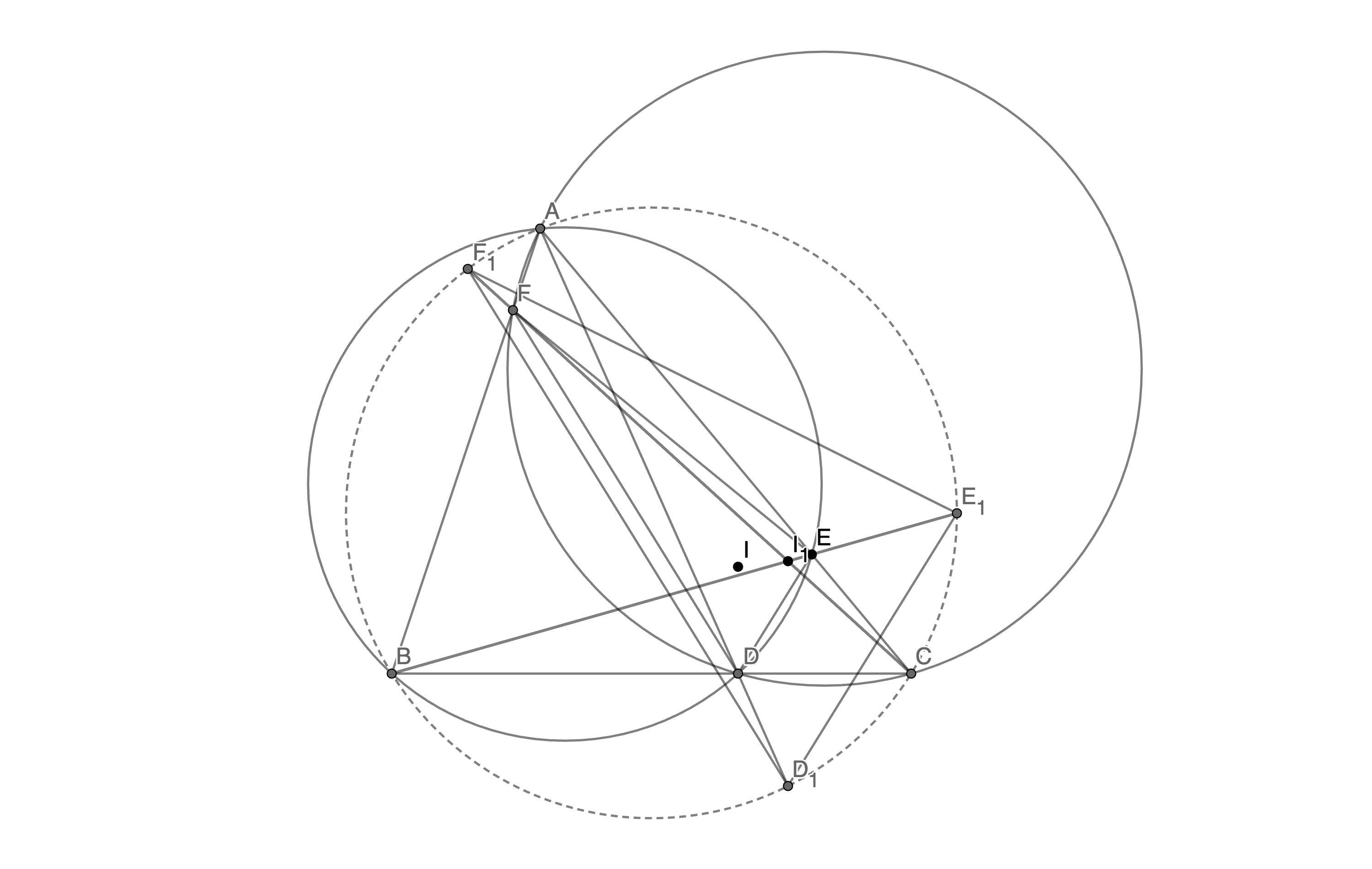Y by Miku_, tiendung2006, son7, ImSh95, Rounak_iitr, Tastymooncake2, ItsBesi
Let  be an interior point on the side
be an interior point on the side  of an acute-angled triangle
of an acute-angled triangle  . Let the circumcircle of triangle
. Let the circumcircle of triangle  intersect
intersect  again at
again at  and the circumcircle of triangle
and the circumcircle of triangle  intersect
intersect  again at
again at  . Let
. Let  ,
,  , and
, and  intersect the circumcircle of triangle
intersect the circumcircle of triangle  again at
again at  ,
,  and
and  , respectively. Let
, respectively. Let  and
and  be the incentres of triangles
be the incentres of triangles  and
and  , respectively. Prove that
, respectively. Prove that  are concyclic.
are concyclic.





![\[
\begin{cases}
\text{the set } A \text{ has at least } 4 \text{ elements} \\
\text{the element } 1+1 \text{ is invertible}\\
x+x^4=x^2+x^3 \text{ holds for all } x \in A
\end{cases}
\]](http://latex.artofproblemsolving.com/b/6/9/b6993ee76eb3792e08d441f5d5c463247c392c4a.png) a) Prove that if a ring
a) Prove that if a ring 

 Finally
Finally 





![[asy]
import graph; size(28.259587460059326cm); real lsf=0.5; pen dps=linewidth(0.7)+fontsize(10); defaultpen(dps); pen ds=black; real xmin=-3.647195849593462,xmax=24.612391610465863,ymin=-7.509267023422269,ymax=5.573532154808459;
pen qqwuqq=rgb(0.,0.39215686274509803,0.);
pair A=(7.04,2.68), B=(5.56,-2.08), C=(11.84,-1.9), D=(8.406260425428417,-1.9984192871692494), F=(6.625518995492593,1.3469394719896899), E_1=(11.51418510673573,1.598202569865462), F_1=(5.933180208263576,1.7780431876423513), D_1=(8.968848272394865,-3.9248615561455518), I=(8.352856644003863,-0.13522069080146587), I_1=(8.857582314416177,-0.04291591111145887);
draw(A--B--C--cycle,linewidth(2.)+red); draw(D_1--E_1--F_1--cycle,linewidth(2.)+qqwuqq); draw(D--(9.486520842231533,0.34561136303741335)--F--cycle,linewidth(2.)+blue);
draw(A--B,linewidth(2.)+red); draw(B--C,linewidth(2.)+red); draw(C--A,linewidth(2.)+red); draw(circle((6.9216226068641475,0.10672238273971847),2.575999010616734),linewidth(2.)); draw(circle((8.655353603542784,-0.4323368347149838),3.5065663885348504),linewidth(2.)); draw(circle((10.03811586962979,1.0168463262495604),3.4285243050378944),linewidth(2.)); draw(D_1--E_1,linewidth(2.)+qqwuqq); draw(E_1--F_1,linewidth(2.)+qqwuqq); draw(F_1--D_1,linewidth(2.)+qqwuqq); draw(circle((8.30438487295115,1.5559055437042604),1.6918207510320091),linewidth(2.)+linetype("4 4")); draw(D--(9.486520842231533,0.34561136303741335),linewidth(2.)+blue); draw((9.486520842231533,0.34561136303741335)--F,linewidth(2.)+blue); draw(F--D,linewidth(2.)+blue); draw(B--E_1,linewidth(2.)); draw(C--F_1,linewidth(2.)); draw(A--D_1,linewidth(2.));
dot(A,ds); label("$A$",(7.119243700763566,2.8680241094519623),NE*lsf); dot(B,ds); label("$B$",(5.451464768694492,-2.5429919812610295),NE*lsf); dot(C,ds); label("$C$",(11.714901202465018,-1.709102515226493),NE*lsf); dot(D,ds); label("$D$",(8.24962719916594,-2.48739935019206),NE*lsf); dot((9.486520842231533,0.34561136303741335),linewidth(4.pt)+ds); label("$E$",(9.63944297589017,0.19957781814144593),NE*lsf); dot(F,linewidth(4.pt)+ds); label("$F$",(6.693033529234802,1.4967392097507248),NE*lsf); dot(E_1,linewidth(4.pt)+ds); label("$E_1$",(11.51106155521213,1.9600111353254672),NE*lsf); dot(F_1,linewidth(4.pt)+ds); label("$F_1$",(5.710897047016347,2.0156037663944364),NE*lsf); dot(D_1,linewidth(4.pt)+ds); label("$D_1$",(9.102047542223467,-4.247832667376081),NE*lsf); dot(I,linewidth(4.pt)+ds); label("$I$",(8.286688953211918,-0.02279270613443046),NE*lsf); dot(I_1,linewidth(4.pt)+ds); label("$I_1$",(8.8611461409246,0.1810469411184562),NE*lsf);
clip((xmin,ymin)--(xmin,ymax)--(xmax,ymax)--(xmax,ymin)--cycle);
[/asy]](http://latex.artofproblemsolving.com/5/3/0/53049f0832c742fef05d53268bca8a70fa0a2f79.png)






